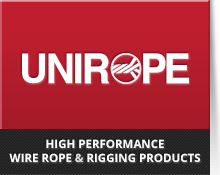TWIN-PATH® and Round Sling Mechanical Considerations and Test Procedures
- Load both paths of Twin-Path® or Roundslings slings equally. Do not side load. Do not load the edge of the sling.
- Determine the weight of the load. The weight of the load shall be within the rated capacity of the sling.
- Select a sling having suitable characteristics for the type of load, hitch, and environment.
- Slings shall not be loaded in excess of the rated capacity. Consideration shall be given to the angle of the lift, which may affect the lifting capacity. Diameters of pins and edges also may affect the capacity of the lifting sling.
- Slings used in a choker shall not be forced to tighten around the load by pounding with hammers or other objects. Choker hitches are the least effective way to use a sling based on capacity. Two chokers should be used to balance the load. One choker in the center of the load may create an unbalanced situation, which could lead to an accident.
- Slings used in a basket hitch must have the load balanced to prevent slippage and accidents.
- Slings used with fittings shall be compatible with the fittings used. The lifting capacity shall be rated at the lower of the fitting or sling. Fitting openings shall be of the proper shape and size to assure that the sling will seat properly.
- Slings in contact with edges, corners, protrusions, or abrasive surfaces shall be protected with a material of sufficient strength, thickness, and construction to prevent damage. The pin area of a shackle can cause synthetic slings to cut or tear.
- Slings shall not be dragged on the floor or drawn across other surfaces that may damage the sling.
- Slings shall not be twisted or tied in knots to shorten.
- Slings can be damaged by resting loads on them or by pulling slings from under a load.
- Do not drop objects on slings or run over them with vehicles.
- Damaged slings shall not be used.
- Sling hitches must provide control of the load.
- Portions of the human body shall be kept from between the sling and the load, and from between the sling and any attachment to lifting devices such as hooks.
- Personnel shall stand clear of suspended loads.
- Personnel shall not ride on the sling or suspended loads.
- Avoid shock loading.
- Twisting and kinking the legs of the sling shall be avoided.
- Load applied to the hook should be centered in the bowl of the hooks. Do not point-load the hook.
- During lifting with or without the load, all personnel shall be alert for possible snagging.
- The slings shall contain or support the load from the sides above the center of gravity so the load will not tilt when the load is lifted.
- Synthetic roundsling users shall be trained in the selection, inspection, cautions to personnel, environmental effects, and rigging practices.
- Only legibly-marked or -labeled slings must be used. If the tag is not legible or missing, the sling must not be used.
- Keep labels or tags away from the load, the hook, and the angle of choke.
- Synthetic slings shall be inspected before each lift.
Test Procedures for TWIN-PATH® and Roundsling Products
- Proof tests shall consist of pulling the slings to twice their rated capacity.
- Testing of Twin-Path® and Uni-Path® sling products shall be performed on a testing machine that meets or exceeds the standards as described in ASTM E-4.
- Repaired slings shall be proof-tested by Unirope before they are returned to service. Certifications shall be provided to the sling owner.
- Break- and Verification testing shall be as above with results documented. Pin sizes for breaking strengths tests should be of a diameter.
- for Twin-Path® slings equal to half the the nominal sling width or larger or as per WSTDA RS-1HP.
- for Uni-Path® slings meeting the specification as per WSTDA RS-1.
Below:
Twin-Path Slings slings lift ship sections at St. John’s Shipyard.




